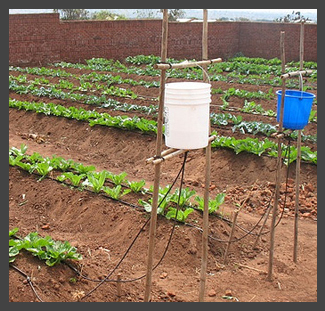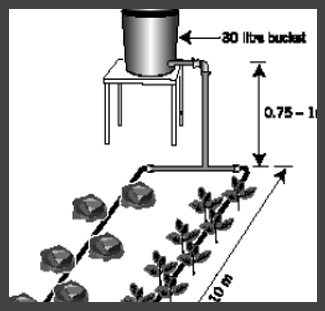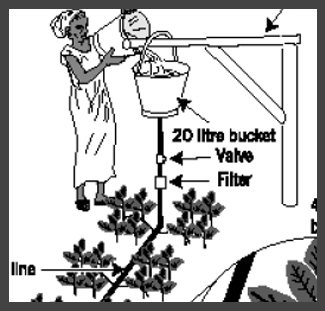Difference between revisions of "Bucket / Farm kits and Drum systems"
| Line 30: | Line 30: | ||
|} | |} | ||
| + | |||
| + | |||
| + | ==Bucket kits links== | ||
| + | |||
| + | '''Smallholder irrigation could change the lives of millions of people'''<br> | ||
| + | Smallholder farmers in sub-Saharan Africa and South Asia are increasingly using small-scale irrigation to cultivate their land. Individually owned and operated irrigation technologies improve yields, reduce risks associated with climate variability and increase incomes, allowing farmers to purchase food, health care and education. There is great potential for many more farmers to benefit from small-scale irrigation. This report presents governments, donors, lending institutions, the private sector and farmers with the opportunity to make well-informed decisions about investments in agricultural water management (AWM) that could change the lives of millions of rural people. | ||
| + | |||
| + | * [http://www.iwmi.cgiar.org/Publications/Other/Reports/PDF/Water_for_wealth_and_food_security.pdf Water for wealth and food security: Supporting farmer-driven investments in agricultural water management]. 2012 study by AgWater Solutions. | ||
==Acknowledgements== | ==Acknowledgements== | ||
* Sijali, Isaya V. [http://www.samsamwater.com/library.php?serie=RELMA%20Technical%20Handbook%20Series DRIP IRRIGATION: Options for smallholder farmers in eastern and southern Africa.] RELMA, 2001. | * Sijali, Isaya V. [http://www.samsamwater.com/library.php?serie=RELMA%20Technical%20Handbook%20Series DRIP IRRIGATION: Options for smallholder farmers in eastern and southern Africa.] RELMA, 2001. | ||
Revision as of 05:17, 30 August 2012
In bucket kit drip irrigation, water flows into the drip lines from a bucket reservoir placed 0.5–1 m above the ground to provide the required water pressure. The efficient use of water that is possible with drip irrigation enables a farmer to grow vegetables using 30–60 litres of water daily during the crop growing season.
A bucket kit system comprising two 15-m long drip lines can be used to grow 50 plants such as tomato, egg plant and similar crops requiring a spacing of 60 cm along the plant rows; 100 plants of spinach, cabbage, kale, pepper and similar plants requiring a spacing of 30 cm along the plant rows; or 300 plants of onion, carrot and similar plants requiring a spacing of 10 cm. The standard bucket kit system consists of two drip lines placed 0.5 m apart on a bed with a width of 1 m. A bucket is placed on a stand at one end of the bed and connected to the drip lines. These bucket kit systems can irrigate 10–20 m2, depending on the length of the drip tube and plant spacing.
The bucket should be filled once in the morning and once in the afternoon to supply 30–60 litres of water to the crop per day. The actual amount of water depends on crop water requirements and rainfall. In very dry areas and during the dry season 60 litres of water will be required per day.
There is a growing demand for bucket kits. For example, Chapin bucket kits are reported to be in use in over 80 countries world wide and the demand is growing fast. By 2001, more than 5,000 kits had been sold by KARI to Kenyan farmers who have adopted the bucket drip irrigation system. It has been shown that plants that are watered using the bucket system have higher yields.
The average cost of a bucket kit is US$15.
| Bucket kits | ||
|---|---|---|
Bucket kits links
Smallholder irrigation could change the lives of millions of people
Smallholder farmers in sub-Saharan Africa and South Asia are increasingly using small-scale irrigation to cultivate their land. Individually owned and operated irrigation technologies improve yields, reduce risks associated with climate variability and increase incomes, allowing farmers to purchase food, health care and education. There is great potential for many more farmers to benefit from small-scale irrigation. This report presents governments, donors, lending institutions, the private sector and farmers with the opportunity to make well-informed decisions about investments in agricultural water management (AWM) that could change the lives of millions of rural people.
- Water for wealth and food security: Supporting farmer-driven investments in agricultural water management. 2012 study by AgWater Solutions.
Acknowledgements
- Sijali, Isaya V. DRIP IRRIGATION: Options for smallholder farmers in eastern and southern Africa. RELMA, 2001.



